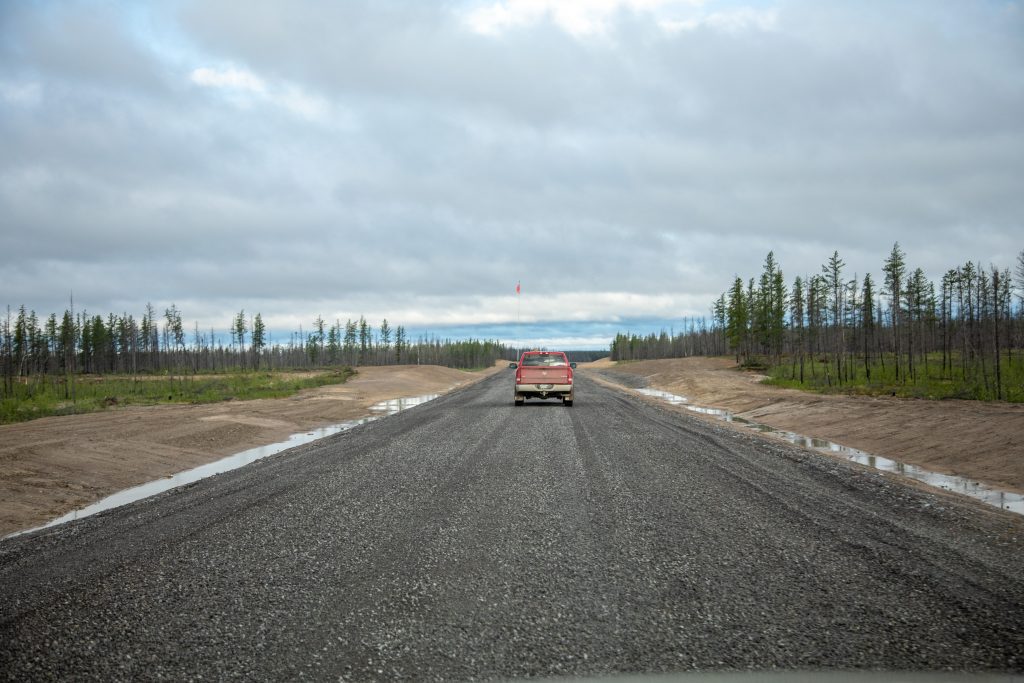The Tłı̨chǫ Highway is scheduled to open this fall and according to Whatì Chief Alfonz Nitsiza, residents are “practically counting down the days” until opening.
“We’ve been talking about this for many years, they’re excited to see that this is actually happening,” he said.
Nitsiza expects the opening of the highway will bring a large influx of visitors to the community and with them new opportunities for Whatì. Some entrepreneurs are already preparing new businesses.
“Two new bed-and-breakfasts are opening up in addition to the hotel which is in operation. In addition, we are planning for the development of a Whatì training centre opening up in the future.”
The training will cover business in a general sense but will have a definite focus on tourism.
The chief said the Tłı̨chǫ Government’s economic development group also has a tourism working group and a strategic plan for tourism.
“We are confident business will be opening up with these programs,” said Nitsiza.
The GNWT’s Department of Industry, Tourism and Investment (ITI) has been involved with helping prepare the community for several years.
“ITI has hosted a number of open houses to build community interest and understanding about the economic opportunities that can be realized from road travelers and an influx of visitors to their community,” said Drew Williams, communications manager for ITI.
“We continue to provide training opportunities, readiness workshops and funding proposals.”
He added the department has supported some community members in exploring business ideas and developing business plans.
More recently Williams said ITI has been working to build the marketing content resources, such as photography and videography in a partnership with NWT Tourism. ITI was also involved in the NorthernMost Host training workshop for community members.
He also said ITI is assisting the community assess the development of a potential day use area.
‘It’s going to change the community’
While Chief Nitsiza said Whatì is excited for the opening, there are still some concerns.
“They also are concerned about the impact and the influx of people that might be coming out. It’s going to change the community,” he said.
“When people talk about change, there’s always some fear.”
But the chief said with good information people will come to realize the benefits the road will offer. One example is how goods will be shipped in for community members.
“Right now, if they’re going to be doing any renovation or projects, they have to plan a year in advance to get materials on the ice road,” he said.
“They have to (stockpile groceries) during the winter… because the price is so high to get things in. It costs almost two dollars a pound to get things on the plane with freight costs. It costs almost $600 for a return trip to Whatì from Yellowknife.”
Beyond the social impacts of opening the highway, Nitsiza says there are still some outstanding issues around emergency response along the two-lane all-season road.
Currently there is no cellphone service along Highway 3 between Yellowknife and Behchokǫ̀, and the same would be true between Behchokǫ̀ and Whatì. Nitsiza says he has been in communication with both the GNWT and NorthwesTel.
Monfwi MLA Jackson Lafferty has brought the issue up in the Legislative Assembly on several occasions.
Jurisdiction in the case of an emergency will also be top of mind for the community.
“Where there’s a highway, there’s always accidents. Who are the first responders and communication are very important and we’re still working on those issues,” Nitsiza said.
Chucker Dewar, the NWT Fire Marshal, said MACA is working closely to build emergency response capacity with both Behchokǫ̀ and Whatì.
“Initial focus is related to ensuring all necessary fire services foundational elements are in place to meet the requirements of the Safety Act and Workers Safety and Compensation Services Firefighters Code of Practice,” said Dewar.
Dewar also said the department is exploring telecommunications along Highway 3, by building education and awareness campaigns about safe driving rules and practices and improving signage along Highway 3.

A finished section of the Tłı̨chǫ Highway. The territorial and Tłı̨chǫ government’s are collaborating on a project “piggybacking” on the road that could bring a fibre optic cable to Whatì. (Photo courtesy of the GNWT.)
Mining activity
With improved access and infrastructure comes greater possibilities for mining on Tłı̨chǫ land.
“This is the highway going into the heart of Tłı̨chǫ land, with surface and subsurface rights,” Nitsiza said.
“There is a lot of potential for mineral deposits and exploration so the infrastructure for that is needed in the North to attract investors and people that want to explore for mineral development.”
Currently, the mining company Fortune Minerals has a claim on a chunk of land Nitsiza referred to as the “doughnut hole” which predates the Tłı̨chǫ land claim and self-government agreement.
Fortune Minerals calls the area the NICO Project.
“Fortune Minerals’ NICO Cobalt-Gold-Bismuth-Copper Project is a development stage asset with over $135 million invested to advance it from discovery through to its current status as one of the few potential new sources of cobalt supply globally,” said Troy Nazarewicz, investor relations manager for Fortune.
Nazarewicz also highlighted the importance of cobalt in new technology and lithium ion batteries. He added this bismuth deposit is “the largest in the world.”
The site has enough mineral reserves to sustain a 20-year mine, Nazarewicz said. With an environmental assessment approval and secured key permits for the proposed mine and mill in the Northwest Territories, Fortune is just looking to secure a refinery site in southern Canada and more funding.
Once that’s done, Nazarewicz said it’ll take two years to build the mine and refinery.
The Tłı̨chǫ Highway will be a “key enabler” for the future of a mine at the site as an all-season road will be needed to transport metal concentrate.
“The Tłı̨chǫ Highway, together with the spur road Fortune plans to construct to the mine, will also enable workers to commute to the mine for work from their homes in nearby communities,” Nazarewicz said.
Fortune has completed cooperation and access agreements with Tłı̨chǫ Government and is negotiating a participation agreement. They have also completed a socio-economic agreement with the GNWT, formalizing “mutual objectives to maximize northern and Indigenous employment, training, business opportunities, and education to benefit residents.”
Whatì’s chief says that things have slowed down due to the COVID-19 pandemic “but they’re keeping us informed with what they’re doing.”
The Tłı̨chǫ Highway is on schedule and on budget according to information on the Department of Infrastructure’s website with the opening coming in the fall of this year.









